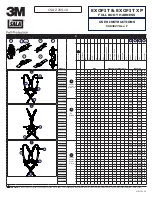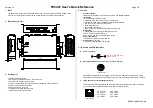
KTR-STOP
®
L light-xxx A-xx-xx
Operating/Assembly instructions
KTR-N
Sheet:
Edition:
445123 EN
12 of 21
2
Please observe protection
note ISO 16016.
Drawn:
2020-09-25 Shg/Wie
Replacing:
KTR-N dated 2019-11-21
Verified:
2020-11-05 Shg
Replaced by:
If several brakes are assembled we recommend to connect the pressure connection for
each brake individually (in parallel) (see illustration 11).
Please note, if several brakes are connected in a series (see illustration 12), the braking
effect of all following brakes may become effective slightly delayed.
•
Connect the pressure oil line to the pressure connec-
tions of the brake (see illustration 10, 11 and 12). For
that purpose remove the screw plugs beforehand.
•
Mount a miniature measuring coupling with a minia-
ture measuring hose to the venting hole (see illustra-
tion 10, 11 and 12), for that purpose the screw plug
needs to be removed beforehand. Discharge the end
of the miniature measuring hose in a suitable collec-
tion container.
!
The hydraulic lines have to be flushed
before connecting to the brake to pre-
vent any particles from penetrating the
brake. If the lines are not flushed suffi-
ciently, the gaskets may be damaged
and the operation of the brake is no
longer ensured.
Illustration 11: Pressure connection
of several brakes (in parallel)
Illustration 12: Pressure
connection
of several brakes (in a series)
!
The pressure connection on top serves for venting the brake. For a flushing system make
use of one of the pressure connections on top.
Always connect the brake consisting of two halves to a pressure line (see illustration 11 and
12), since the brake disk is loaded with the full braking power on one side in case if one half
of the brake fails.
!
With the parallel connection of brakes (see illustration 11) each brake needs to be vented
individually.
!
It is not recommended to use steel plugs for venting.
•
Connect the leakage oil pipe to the brake (see illustration 10, 11 and 12). For that purpose remove the sealing
plugs beforehand.
If no leakage oil line is connected, a vacuum may be generated inside the brake which will
damage the gaskets.
!
Never give any pressure on the leakage oil line. Gaskets and scrapers will be destroyed in
this way.
In order to locate a leakage immediately, it is recommended to use a transparent hose and
collection container. Since higher pressures (5 bars at the maximum) are not generated, a
pneumatic hose may be used, too. Inspect the brake for leakages regularly.
4
Assembly
4.6 Pressure connection of several brakes







































